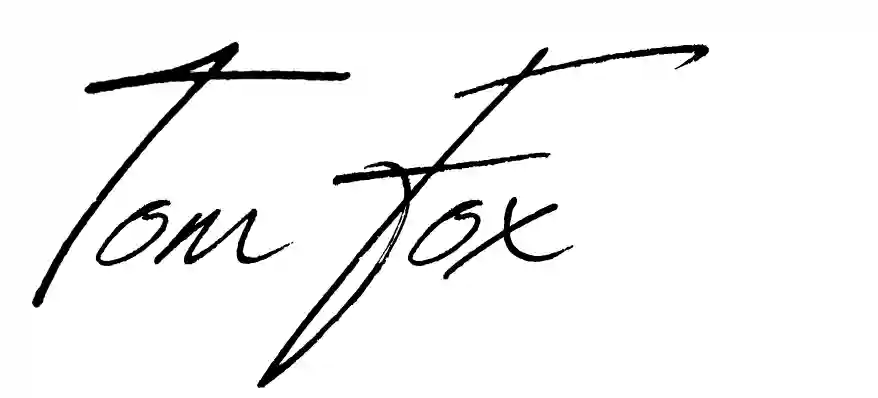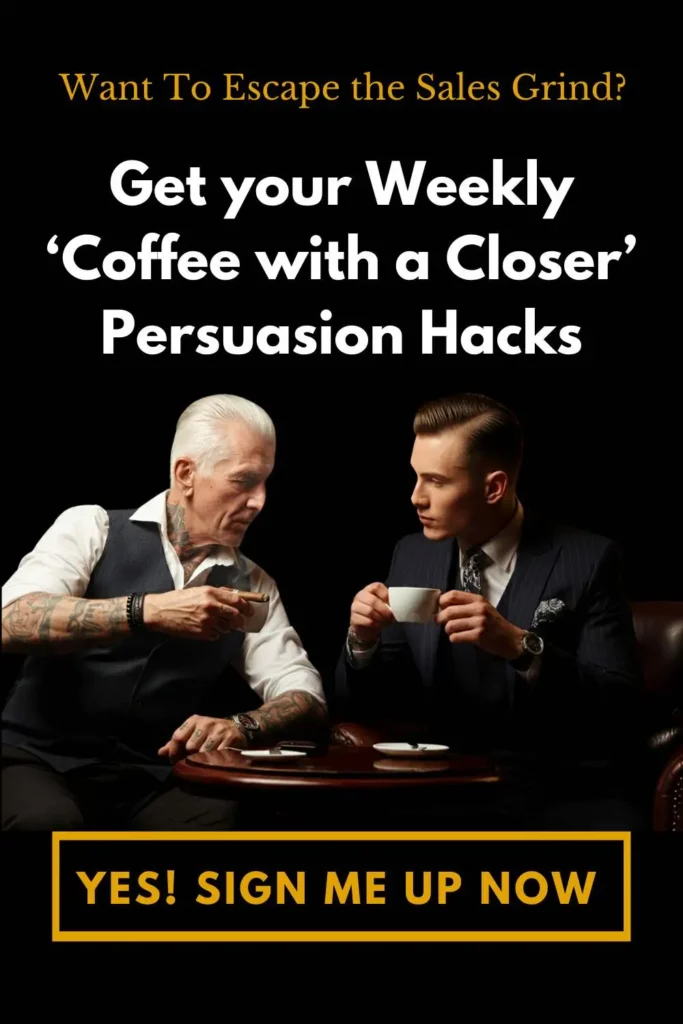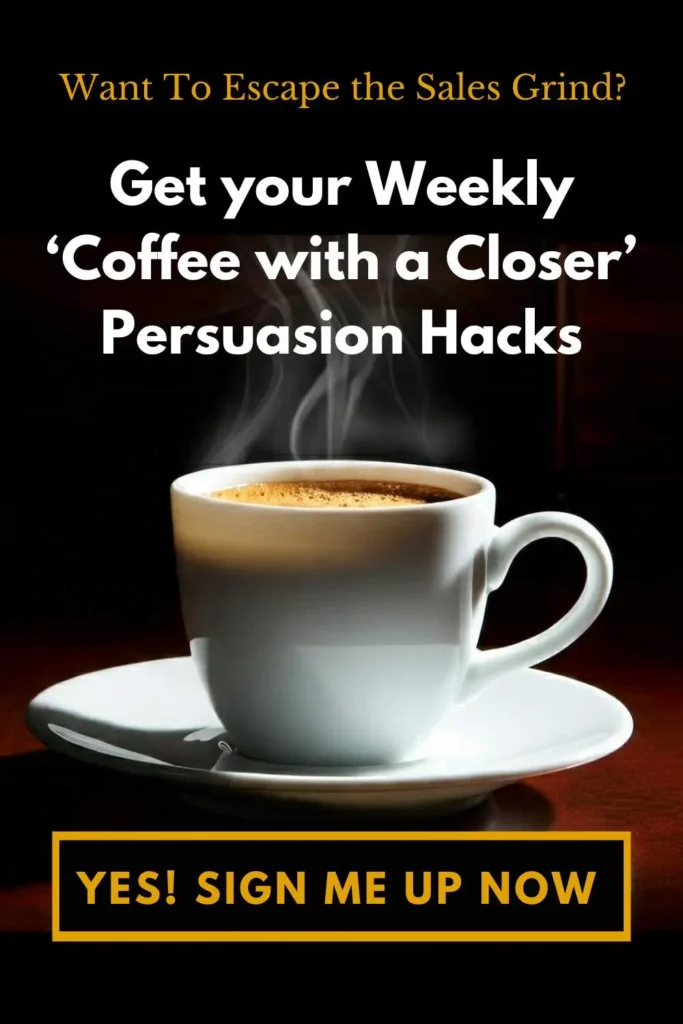Understanding Customer Motivation: Why Timing is Everything
Alright, you urgency-creating champions, let’s talk about the compelling event.
Now, before you start picturing me setting fires and sounding alarms (though, hey, a little drama can be effective), let me clarify – this isn’t about scaring your prospects or using high-pressure tactics.
It’s about understanding their motivations, identifying their timelines, and creating a sense of urgency that encourages them to take action.
Done with the endless sales theory and ready to actually close more deals? If you want to skip the ‘WHY’ and get straight to the ‘HOW’?
Make “Coffee with a Closer” your next move. Get weekly, battle-tested action steps delivered directly to your inbox – no fluff, just results.
The “Why Now?” Factor
In the sales world, timing is everything. You can have the best product or service in the world, but if your prospect isn’t ready to buy, you’re not going to close the deal.
That’s where the compelling event comes in.
It’s the “why now?” factor, the reason your prospect needs to act sooner rather than later.
It’s the catalyst that pushes them off the fence and into your arms (or at least into your sales funnel).
Identifying the Compelling Event: It’s Like Reading Their Mind
To uncover the compelling event, you need to dig deep and understand your prospect’s motivations.
What are their pain points? What are their goals? What are their challenges?
And most importantly, what are the consequences of inaction?
Here are a few questions to help you identify the compelling event:
- “What are your biggest challenges right now?”
- “What are your goals for the next year?”
- “What’s preventing you from achieving those goals?”
- “What are the consequences of not addressing these challenges?”
- “What’s your timeline for making a decision?”
- “What are your current priorities?”
- “What external factors are influencing your decision-making?”
- “Are there any upcoming deadlines or events that are relevant to this decision?”
- “What are the potential costs of delaying this decision?”
Examples of Compelling Events
- Contract expirations: “Your current contract is expiring soon. Now is the perfect time to switch to a better solution.”
- New regulations: “New regulations are coming into effect that will impact your business. Are you prepared?”
- Deadlines: “The deadline for this offer is approaching. Don’t miss out!”
- Competitor actions: “Your competitors are already using this technology. Don’t fall behind.”
- Industry trends: “The industry is shifting, and you need to adapt to stay ahead of the curve.”
- Financial incentives: “Take advantage of our limited-time discount and save 20% on your purchase.”
- Seasonal opportunities: “Now is the perfect time to upgrade your equipment before the busy season hits.”
- Upcoming events: “Our annual conference is just around the corner. Register now and secure your spot.”
- Internal initiatives: “Your company is undergoing a major expansion. Is your current infrastructure able to support your growth?”
“Don’t just sell, ignite action! Uncover the compelling event and watch your prospects race to say ‘yes’.”
Tom Fox
The Power of Urgency (Without the Pressure)
Once you’ve identified the compelling event, you can use it to create a sense of urgency without resorting to high-pressure tactics.
Here are a few examples:
- “This offer is only available for a limited time.”
- “We have a limited number of spots available.”
- “Don’t miss out on this opportunity to save time and money.”
- “Act now and get a special bonus.”
- “Schedule a call before [date] and receive a complimentary consultation.”
- “This discount expires at midnight!”
- “Early bird registration ends on [date].”
The Psychology of the Compelling Event
The compelling event taps into several psychological principles that drive action:
Loss Aversion:
The Pain of Loss:
Loss aversion is a powerful cognitive bias that suggests we feel the pain of a loss more strongly than the pleasure of an equivalent gain.
This means that the fear of losing something motivates us more than the prospect of gaining something of equal value.
Framing Your Message:
In sales, you can leverage loss aversion by framing your message in terms of what the prospect stands to lose by not taking action.
For example, instead of just focusing on the benefits of your product, you could also highlight the potential costs of not using it, such as lost productivity, missed opportunities, or increased risk.
Example:
“By not implementing our solution, you could be losing [quantifiable amount] in potential revenue each year. Our software can help you optimize your operations and capture those lost opportunities.”
Scarcity:
The Psychology of Scarcity:
Scarcity is a fundamental economic principle that states that the rarer or more difficult something is to obtain, the more valuable it becomes.
This applies not only to tangible goods but also to intangible things like time, opportunities, and experiences.
Creating a Sense of Urgency:
In sales, you can create a sense of scarcity by using phrases like “limited-time offer,” “exclusive deal,” “only a few spots left,” or “while supplies last.”
This triggers a fear of missing out (FOMO) and motivates prospects to take action sooner rather than later.
Example:
“We’re offering a special discount to our first 100 customers. Don’t miss out on this opportunity to save 20% on your purchase.”
FOMO (Fear of Missing Out):
The Social Proof Effect:
FOMO is often fueled by social proof, the idea that we’re more likely to do something if we see others doing it.
When we see our peers or competitors benefiting from something, we don’t want to be left behind.
Highlighting Social Proof:
In sales, you can leverage FOMO by highlighting the positive experiences of other customers or by showcasing how your product or service is helping others achieve success.
Example:
“Join the thousands of businesses who are already using our solution to streamline their operations and increase their revenue. Don’t miss out on the opportunity to transform your business.”
The Zeigarnik Effect:
The Power of Incompleteness:
The Zeigarnik Effect is a psychological phenomenon that suggests that incomplete tasks or unresolved issues tend to stay in our minds more than completed ones.
This creates a sense of tension and urgency that motivates us to complete the task or resolve the issue.
Creating Open Loops:
In sales, you can leverage the Zeigarnik Effect by creating “open loops” in your communication.
This could involve starting a story but not finishing it, presenting a problem but not revealing the solution immediately, or asking a question that piques their curiosity.
Example:
“In our next meeting, I’ll share a case study of how we helped a company just like yours achieve a 30% increase in sales.
But first, I want to hear more about your specific challenges.”
Ready to master the art of creating urgency and driving immediate action? Sign up for the “Coffee with a Closer” and receive practical techniques to identify compelling events, craft persuasive messaging, and motivate prospects to make timely decisions.
The Compelling Event: Your Secret Weapon for Closing Deals
By understanding your prospect’s compelling event, you can tailor your message, create a sense of urgency, and increase your chances of closing the deal.
It’s like giving them a gentle nudge in the right direction (without pushing them off a cliff).
So, go out there and uncover those compelling events. Your sales numbers (and your prospects’ sense of urgency) will thank you.

PS: Want the most powerful persuasion hacks delivered straight to your inbox? Sign up for the “Coffee with a Closer” today!


